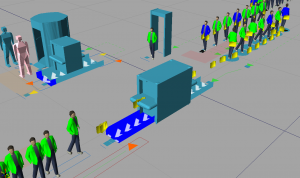 Airports are moving towards the increased use of new generation full body scanners and 3D cabin baggage screening equipment to process passengers through security. In fact, body scanners are already in use across most of the UK’s busiest airports and the screening equipment is being trialled in a number of locations. These innovative technologies offer the potential to enhance airport security at the same time as improving the passenger experience, but airports need to take care that in reaching for the benefits they don’t kill their operational efficiency.
Airports are moving towards the increased use of new generation full body scanners and 3D cabin baggage screening equipment to process passengers through security. In fact, body scanners are already in use across most of the UK’s busiest airports and the screening equipment is being trialled in a number of locations. These innovative technologies offer the potential to enhance airport security at the same time as improving the passenger experience, but airports need to take care that in reaching for the benefits they don’t kill their operational efficiency.
In August 2019 the Prime Minister announced plans that will require all major airports to introduce new 3D cabin baggage screening equipment by 1st December 2022. This will mean that passengers no longer need to remove their portable computers, other large electrical items or Liquids, Aerosols and Gels (LAGS) from their hand luggage. In addition to this, the Department for Transport (DFT) is guiding airports towards a future in which 100% of passengers are automatically scanned using body scanners. Currently, most airports utilise x-ray scanners with only some passengers being screened with body scanners.
Increasing the number of passengers that are required to be scanned up to 100% has the potential to significantly change security lane processing rates and possibly increase passenger wait times if not designed carefully. The 3D cabin baggage equipment will speed up divestment. This could shift the location of the main constraints in the process to the scanners if under-provisioned which impacts where queues form, space requirements and overall lane layout. If not addressed in a timely fashion this could reduce passenger satisfaction and impact import KPIs.
These potential impacts are why airports will be required to carefully redesign their security areas including central search areas and other security positions such as staff access and transfer passenger areas to ensure that the operation remains efficient and passengers are satisfied. As part of our airport modelling and operational improvement services we specialise in helping airports to understand and design their future security layouts to best balance cost, efficiency and passenger experience. We can quickly assess multiple scenarios that use different combinations of manufacturers equipment to understand the optimal amount of hardware for an airport to purchase. We have practical experience of assessing the impact of C3 security regulations on airport processes in some of the countries busiest terminals and our team can provide everything from modelling of individual lanes through to the data collection, layout and assessment of entire terminal security areas and other posts.
Author: Irene Bravo, ATM Consultant



Recent Comments